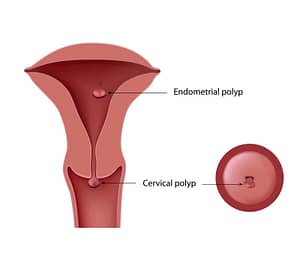
Uterine or Endometrial Polyps
What are Polyps?
Endometrial or uterine polyps are benign growths of the lining of the uterus (endometrium) that may be a factor in subfertility in women. There is a concern that polyps may interfere with fertility by impeding the movement of sperm or embryo, or by impairing implantation. There is also a concern that polyps may become cancerous under certain conditions, particularly after menopause and in women over 60. The conditions that promote the growth of endometrial polyps (rather than the polyps themselves), may be responsible for infertility and cancer issues and should be addressed.
What Causes Uterine Polyps?
The jury is out as to the exact cause of uterine polyps, but given that the endometrial lining is responsive to hormones, polyps may be caused by:
- Increased aromatase activity – this is the enzyme that creates estrogen
- Increased insulin levels – insulin increases the activity of aromatase, causing more estrogen production, it also promotes the production if Insulin-like Growth Factor 1, which stimulates tissue growth.
- Chronic tamoxifen treatment
- Estrogen/progesterone imbalance – stimulation from too much estrogen or too little progesterone to curb estrogen activity may result in polyp growth
Risk Factors for Polyps
The following risk factors may increase your chances of having endometrial polyps:
- Aging
- Excess weight, obesity, high BMI – fat cells produce estrogen and inflammatory chemicals, having more body fat, therefore, leads to higher levels of estrogen and inflammation, both of which may be involved in polyp growth
- Unbalanced estrogen – progesterone helps to balance estrogen. If there is too much estrogen or too little progesterone, polyps can grow
- Lack of progesterone – as mentioned above, progesterone keeps estrogen in check. A lack of progesterone from lack of ovulation or just low progesterone production can increase polyps.
Signs and Symptoms of Uterine Polyps
If you have polyps you may experience:
- Heavy periods
- Abnormal uterine bleeding – after menopause, or between periods
- Infertility
How are Uterine Polyps Diagnosed?
Pelvic and transvaginal ultrasound is done to diagnose polyps.
What is the conventional treatment for uterine polyps?
Surgical removal is an effective treatment for existing polyps, however, it does not address the hormonal or physiological factors that caused the polyps. So polyps may recur and conditions may still not be optimal for fertility.
What is the Naturopathic Treatment for Uterine Polyps?
As a naturopathic doctor, I aim to:
- Moderate aromatase activity – this is mainly accomplished through diet.
- Encourage you to eat a clean diet to reduce insulin requirements and moderate estrogen level and activity and decrease inflammation.
- Facilitate weight loss, if needed, to reduce excess estrogen production from fat tissue.
- Enhance phase I and phase II liver metabolism of estrogen and estrogen metabolites.
- Support healthy production of progesterone.
These are all doable through naturopathic medicine. Not only can this resolve existing polyps, but it can also prevent new ones and improve fertility by creating optimal conditions for conception, implantation, and pregnancy.
Medically Reviewed by Dr. Pamela Frank
Uterine Polyps References
Ricciardi E, Vecchione A, Marci R, Schimberni M, Frega A, Maniglio P, Caserta D, Moscarini M. Clinical factors and malignancy in endometrial polyps. Analysis of 1027 cases. Eur J Obstet Gynecol Reprod Biol.
2014 Dec;183:121-4. doi: 10.1016/j.ejogrb.2014.10.021. Epub 2014 Oct 30.
Jayaprakasan K, Polanski L, Sahu B, Thornton JG, Raine-Fenning N. Surgical intervention versus expectant management for endometrial polyps in
subfertile women. Cochrane Database Syst Rev. 2014 Aug 30;8:CD009592. doi: 10.1002/14651858.CD009592.pub2.
Su T, Sui L. Expression and significance of p63, aromatase P450 and steroidogenic factor-1 in endometrial polyp. Zhonghua Fu Chan Ke Za Zhi.
2014 Aug;49(8):604-8.
Indraccolo U, Di Iorio R, Matteo M, Corona G, Greco P, Indraccolo SR. The pathogenesis of endometrial polyps: a systematic semi-quantitative review.
Eur J Gynaecol Oncol. 2013;34(1):5-22.
Özkan NT, Tokmak A, Güzel Aİ, Özkan S, çİçek MN. The association between endometrial polyps and metabolic syndrome: A case-control study.
Aust N Z J Obstet Gynaecol. 2015 Jun;55(3):274-8. doi: 10.1111/ajo.12339. Epub 2015 Jun 5.
Esteller M, Garcia A, Martinez-Palones JM, Xercavins J, Reventos J. Endometrial carcinoma in tamoxifen-treated breast cancer patient: clinicopathological, immunohistochemical, and genetic analysis.
Int J Gynecol Pathol. 1999 Oct;18(4):387-91.